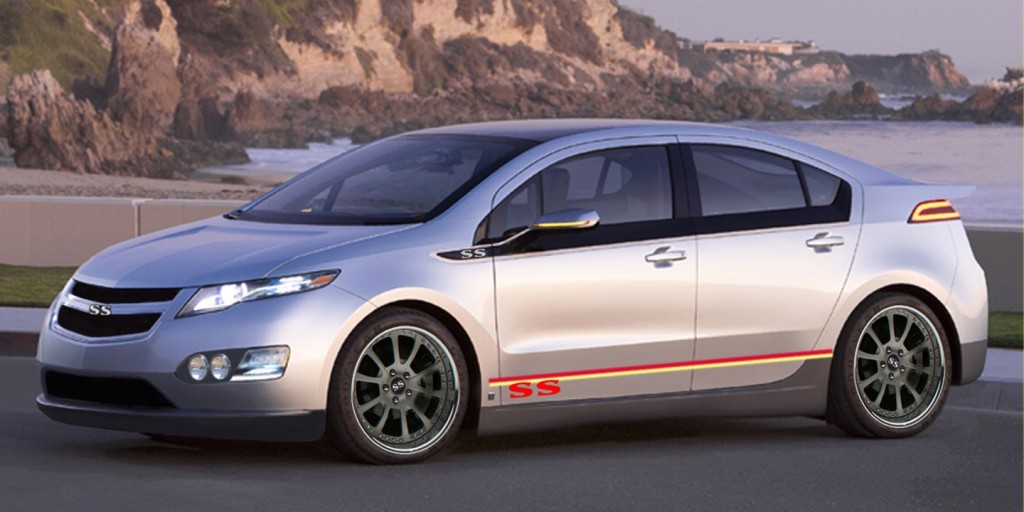
2013 Chevrolet Volt SS with tuner wheels, conception by artist Rick Feibusch
Yesterday's drive in a 2011 Chevrolet Volt prototype got us thinking. The Volt has good performance, equivalent to a regular subcompact with a V6 engine. But what would you do to make a performance Volt? Maybe, in best Chevy tradition, a ... Volt SS?
We asked vehicle line executive Frank Weber: How would you boost Volt performance? As always, his answer was articulate and thoughtful. So well thought-out, in fact, that we suspect we're far from the first people to ask.
We got no concrete details or specs. That's hardly surprising, with the very first Volt still 20 months from showrooms. But based on Weber's warnings about the challenges in hot-rodding an extended-range electric vehicle, here's our hypothetical spec for the 2013 Chevrolet Volt SS:
- ENGINE: Turbocharged, direct-injection version of existing 1.4-liter gasoline engine (i.e. the engine from the 2011 Chevrolet Cruze!)
- BATTERY PACK: 16 kilowatt-hours of new-generation lithium cells, with software modified to draw more than today's 50 percent of energy content
- DRIVE MOTOR: Revised version with higher output than today's 111 kilowatts (that output spec is in 'Sport' mode, by the way)
- GENERATOR: Again, revised version with more than today's 53 kilowatts of power
- WHEELS / TIRES: We couldn't decide between the optimal aerodynamics of flat spun-aluminum covers, and today's 'tuner style' wheels
- BODY MODIFICATIONS: See artist Rick Feibusch's conception of a 2013 Chevrolet Volt SS, with aero effects, SS trim, and driving lights
Back to Weber: The main point, he told us, is to keep the performance in both modes--electric and gasoline--the same. "We cannot surprise the consumer," he said, "and tell them, sorry, today your car is in a bad mood" because it's switched from battery to engine energy. So the battery power and the power delivered by the gasoline-driven generator must go up in sync.
For a more powerful battery, adding cells seems impossible. The Volt "T-pack" battery is a structural element of the car, and there's just no more room under there. Our alternatives were (a) to pull more power out of today's cells, or (b) to use higher-performance cells in the existing battery.
"For the first Volt," noted Weber, "we are being very, very conservative." GM has to make absolutely, positively sure the battery will last 10 years or 150,000 miles, and still provide the 40 miles of electric range that defines the Volt at the end of its life.
But we got to wondering. After a couple of model years, might GM have enough confidence on cell life and performance that the battery team could tweak the software a little? If they knew it wouldn't hurt battery life to be a little more aggressive with power delivery, the existing battery might do the job. Or maybe two years in, they could fit newer, higher-output cells in the pack.
But then you have to upgrade all the rest of the electrical components, countered Weber. If you're delivering more current from the pack, you may need an electric motor with more than the Volt's 53 kilowatts. You also need beefed-up power electronics, perhaps even more robust wiring. "There's a huge difference between [drive motors with] 110, 130, and 150 kilowatts," Weber cautioned sternly.
On the gasoline side, it's easier: You can add a more powerful motor that puts out greater torque (just like every SS that's ever been built) to run the generator. And, remember, the Volt's 1.4-liter engine is also used in the 2011 Chevrolet Cruze. But in the Cruze, it'll be turbocharged. Voila: More power!
At the end of the discussion, we could swear Weber's eyes almost twinkled. "You will see that a tuner can access electric vehicles differently, more easily," he said. And then he had to leave. Hey ... we can dream, right?

2013 Chevrolet Volt SS with aerodynamic wheel covers, conception by artist Rick Feibusch













